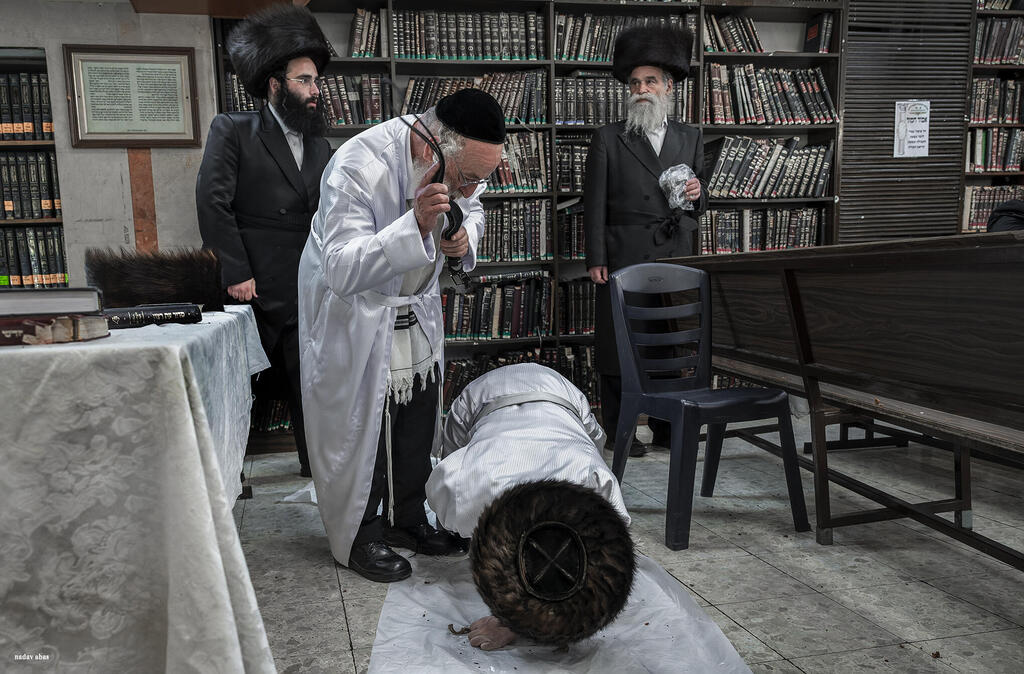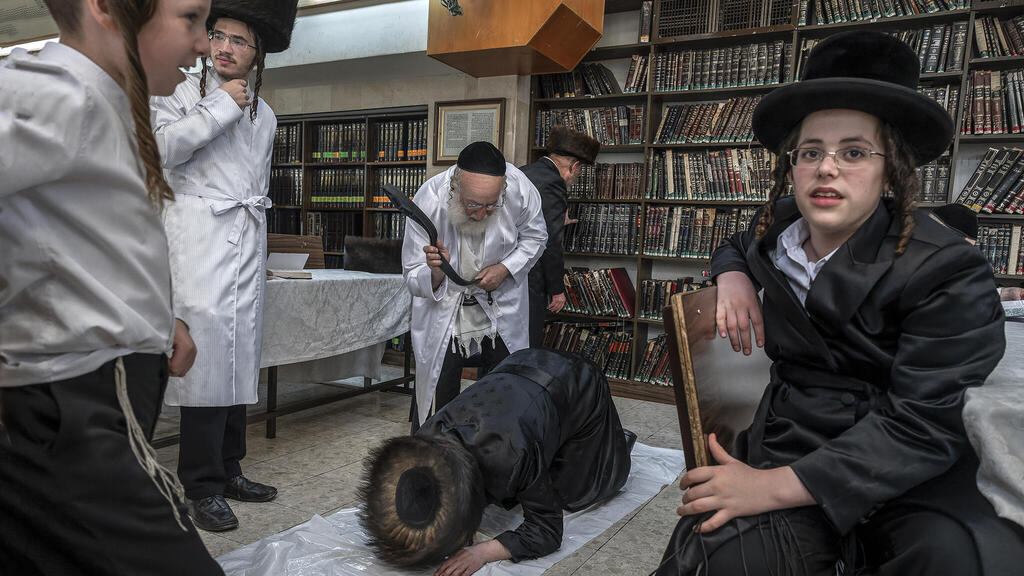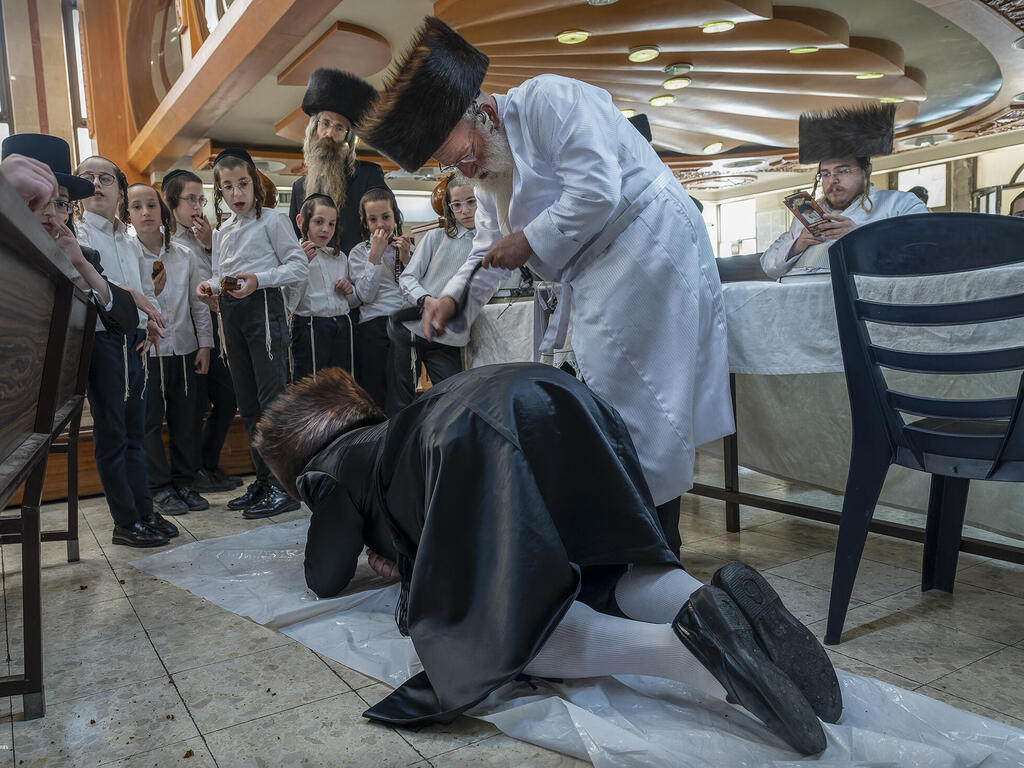Floggings in the Hasidic community in Bnei Brak
(Video: Nadav Abas)
Every Yom Kippur eve in Bnei Brak, following the afternoon prayer, Rabbi Aharon Shafer stands and beats the members of the Hassidic community on the back with a leather belt. "I don't hit hard, G-d forbid. These are weak hits. You feel it a little on the back, nothing more," he clarifies. "You should have mercy on the Jews, it's just a custom, and it happens a few hours before fasting. Some people ask me to hit a little harder, but I don't listen to them.'
More stories:
Flogging is an ancient Jewish custom that apparently originated in the Ashkenazi communities in the Middle Ages. It is mentioned in Siddur Rashi - a medieval treatise on the text of the prayer attributed to the great commentator of the Bible and Talmud, and also appears in the laws of the Ra'ash (Rabbi Asher ben Yechiel) on tractate Yuma in the Talmud. As part of the custom, the synagogue's sexton or one of the rabbis of the community gives the worshipers 39 lashes on their backs with a whip or a leather strap. The goal is to awaken the person to repentance and to atone for wrongdoings, just before the holy day of Yom Kippur.
The custom of flogging did not become as widespread as the custom of kaparot, and it is carried out today mainly among Hasidic and Eastern Jews - but you can find Jews who observe it in other places as well. Shafer says that in the Lelov community in Bnei Brak, the custom has been revived only in the last few decades.
"I renewed the Hasidic custom together with Rabbi Shaul Yitzchak Horowitz, who asked me to whip him, about 30 years ago. The Rebbe, Rabbi Shimon Natan Neta Biderman, entered the study hall and saw that I was whipping him. He asked me: 'Can I have one too?' I was really shaking. What, can the rabbi be whipped? But the Rebbe bent down, and I gave him 39 lashes. He received floggings ecvery year after that, and the custom was revived in the community."
The Rebbe died on Yom Kippur in 2009. "In his last year, the Rebbe was sick and did not feel well enough to receive the flogging. That night he passed away," Shafer recalls sadly.
What is the idea behind the lashes?
"If people have committed an offense that deserves the death penalty (known as "death at the hands of the Heavenly Court), we cannot do anything about it. And if they have committed an offense that deserves one of the death penalties – stoning, burning, killing and strangulation – we cannot do anything. Today we don't have a beit din, or a rabbinical court, there is a state prison. But if, G-d forbid, people have committed an offense for which they must be punished by flogging - they are given floggings."
At the time of the flogging, it is customary for the person doing the flogging to say the verse "And he is merciful, he will atone for iniquity and will not corrupt, and many will answer his father and will not stir up all his anger" three times, and the person being flogged says the confession ("We have sinned, we have betrayed, we have robbed"). The 39 lashes practiced on the eve of Yom Kippur are a reminder of the 39 lashes proscribed by Jewish law as the original punishment for lashes, but they are mainly symbolic.
"Why do they say 'and he is merciful' three times? Because there are 13 words in this verse, and 3X13 is 39," explains Avraham Yosef Rosenblatt, the gabbai of the current rebbe of Lelov. He adds that "everyone wants to come into Yom Kippur as clean and pure as possible, that's why we make every effort. That is why they observe the custom of kaparot, and other customs that do not exist throughout the year. Now that there is no court that gives floggings since the Temple was destroyed, this sort of thing is done in order to say that if a person commits to floggings for an offense he has committed, it will atone for him in this way."
Everyone wants to come into Yom Kippur as clean and pure as possible, that's why we make every effort
"There is a also the matter of paying money for flogging, each one according to his ability, which is also part of the redemption," according to the rabbi. "It is amazing to see how even the Rebbe, the eldest son of the previous Rebbe, continues the custom and receives floggings. Rabbi Shafer does it with courage and awe. Seeing the Rebbe himself crouching on the floor and receiving floggings is a great shock to the public, but it provokes repentance. In the end we are all subject to the Holy One, blessed be He. The greatness of the tzaddik (righteous person) is that he is subject to the Holy One, blessed be He, all year round."
Other religious sects also practice flagellation rituals, incluidng the ritual of Tatbir, practiced by some Shia Muslims to commemorate the kiling of Husayn ibn Ali and his partisans in the Battle of Karbala by forces of the second Umayyad caliph Yazid I. Christians also have engaged in various forms of mortification of the flesh, which include self-flagellation.
3 View gallery


Flogging on the eve of Yom Kippur in the Lelov Hasidic community in Bnei Brak
(Photo: Nadav Abas)
'It's not meant to encourage masochism'
Seeing images of the lashings in the Lelov community will make it clear to you that these are not particularly strong or painful beatings. On the other hand, there is evidence of stronger floggings given in the past in Jewish communities as part of the custom. The Zionist leader Shmaryahu Levin (1867-1935), born in the town of Svisloch, Belarus, described the custom in a memoir of his childhood: "After the afternoon prayer that day (Yom Kippur eve) ... I saw with my own eyes how Jews come and prostrate themselves on the floor of the study hall and Elazar the Sayer of Psalms or, as he was called by many for his skill, Elazar the Bully, stands over them with a whip and flogs them mercilessly. Of course, I knew that this lashing was the ritual floggings, but my heart was awakened. And the floggings were given in perfect order: one in lower part of the body … and two on the back. And so, he would repeat and count: one, one and one, one and two - sometimes fifteen times. And my astonishment grew sevenfold when I saw how the person being flogged got up and threw several copper coins to in the bowl for Elazar. Indeed, it is a wonder – they pay for the whippings."
Rabbi Muni Andar of the Chabad Youth Association says that "some of the Yom Kippur customs already take place on the eve of Yom Kippur, a day that has a special place in Jewish law. On this day, which comes before the fast, there is a mitzvah to eat. The practice of kaparot is usually observed starting from the morning. After the prayer there is a beautiful custom to request from the gabbai a 'lakach' - a kind of honey cake. It is also customary to dip in the mikvah, or ritual bath, on the eve of Yom Kippur, in order to purify oneself for the holy day. Before Yom Kippur, it is customary to light a candle which remains lit throughout the day, and is called the 'candle of life'. Married men usually wear a kittel, a kind of white robe, to resemble angels. Before going to the synagogue, it is customary to bless the children."
The custom of flogging is one of the many customs designed to prepare a person for Yom Kippur. According to Andar "there are different customs, and in Chabad they are usually done before the immersion in the mikvah. It's important to emphasize that the whippings are completely symbolic, it's not an opportunity to settle a score with someone," he laughs. "It's done in a very gentle way. It's more of a caress than a blow. It is customary with us that this is done at three points: on the upper right side of the back, on the upper left side of the back and in the center of the back."
3 View gallery


Lelov Hasidim receive lashes on the eve of Yom Kippur in Bnei Brak
(Photo: Nadav Abas)
"The idea is that it awakens the person and prompts him to seek the true answer in his hear, to be aware of the sins he has committed and not to sin again. Beyond that, we live today in an age where everyone is sure that he is the wisest, most successful and knowledgeable. With whippings you are brought down on all fours, and you are reminded that you are just a human being who needs a lot of prayers and requests from God to be signed for a good year."
Wouldn't that encourage people to harm themselves in dangerous ways?
"G-d forbid. Hasidism came out strongly against injury to the body for atonement, and against attempts to make the soul and body miserable. The Baal Shem Tov refined the idea that the Holy One, blessed be He, loves every Jew as if he were his only son. Even if a child has misbehaved, they try to correct his ways with love. Even the floggings were not intended to make a person correct himself through masochism, but out of love and joy. In the Hasidic world they say: one does penance out of love. It is meant to arouse seriousness, not to make a person depressed, G-d forbid."




